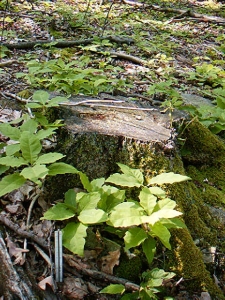Forest managers have many techniques and strategies at their disposal to help landowners meet their forest management goals. Each particular woodlot has its own unique characteristics and undoubtedly requires its own unique forest management prescription. So how is it that forest managers are utilizing trees to help other trees grow? Shouldn’t it be true that each tree is in a constant battle for survival, always trying to outgrow its neighbors for that extra bit of direct sunlight while broadcasting its roots out to grab all the water it can from the soil below? Well, the answer is yes, but there happens to be a way that forest managers are using trees to help other trees survive and grow.
Sustainable forest management requires healthy regeneration of new trees to replace the older harvested mature trees. As mature trees are harvested it opens up the canopy allowing sunlight to reach the forest floor. The opportunity to grow tall and fill the void left by the harvest operation is given to the budding seedlings and saplings however, every year, many of these young trees are lost to deer browse, bear activity, beaver damage, and a host of other woodland inhabitants. Because they are exposed, they are browsed before they have a chance to grow and develop into mature forest trees.

One way forest managers are helping to protect these young seedlings and saplings is by using the residual tree limbs left after logging operations. By leaving tree tops from logged trees in the forest, a natural barrier is created, keeping deer and other animals away from the tender new tree growth trying to develop into the next generation of mature trees.
A part of sustainable forest management is ensuring that a forest is primed for future growth. Downed tree tops and the protection they provide to young growing trees is just one of the benefits. Tree tops, decaying leaf litter, stumps and unusable logs provide much needed protection and habitat to the forest’s smaller inhabitants. Forest managers know that dead and decaying tree matter (stems, bark, leaves, branches) along with den trees, snags and standing dead trees are key components in a healthy forest ecosystem, and the health of the wildlife that depends on that forest. The forest floor is an immensely diverse ecosystem teaming with all types of life including; insects, small mammals, reptiles, fungi and a wide variety of flora and fauna. The forest floor provides nutrients to the soil below it which in turn sustains the trees and everything else in the forest above it.
The northern hardwood forests typical of the north eastern United States commonly have trees that can reach ages of 100 years or more. Sustainable forest management practices allow landowners to benefit from their very valuable resource. The value gained in this way can often far exceed the expense of owning land, and a managed forest makes for a better family heirloom and typically can bring a better price if/when sold.






